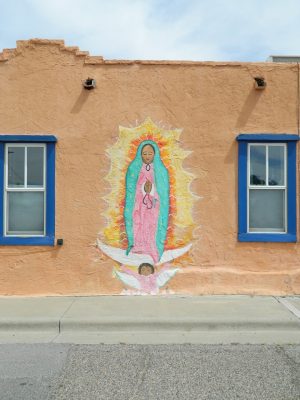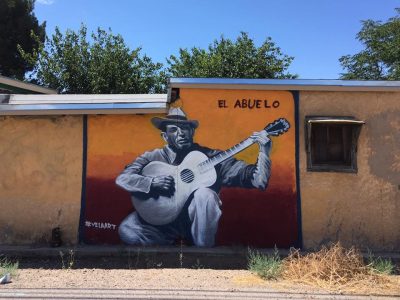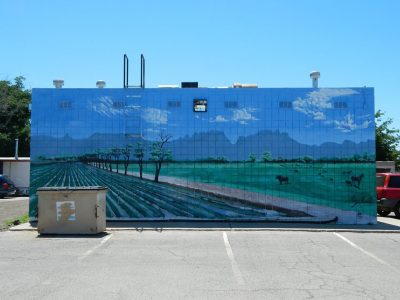Project Showcase: Murals of Las Cruces Project
09 October 2017 – Peter A. Kopp, Norma Hartell, and Jerry D. Wallace

“La Virgincita” by Preciliana Sandoval (2010) in the Mesquite Neighborhood of Las Cruces. Photo credit: Murals of Las Cruces Project.
During the summer of 2015, a group of scholars, students, and artists trekked under the sweltering New Mexico sun with cameras and notebooks in hand to document public murals in the city of Las Cruces. What began as a student project in a public history seminar at New Mexico State University grew into the Murals of Las Cruces Project. We believed the city’s murals had stories to tell about our home in the Mesilla Valley of the Rio Grande near the U.S.-Mexico border, and we wanted to preserve them for posterity. The group also wanted to preserve what is often an ephemeral art form—one produced by street artists expressing grassroots and community-based messages not found in the artwork displayed in formal galleries.
As the Murals of Las Cruces Project (or MoLC) evolved, we established a multi-tiered plan. The team began by deliberating on the definition of “public murals,” eventually settling on “two-dimensional pieces of original artwork visible in the public right of way.” We then mapped Las Cruces into distinct neighborhoods. For the rest of that summer we surveyed one neighborhood at a time on a weekly basis. The MoLC team documented the contents, styles, artistic mediums, physical conditions, artists’ names, dates, and locations of the murals. We also took scores of photos. Our group compiled the information into a database. At the same time, we began a social media campaign on Facebook and Instagram to share our work with others and to crowdsource information from what turned out to be a tremendously engaged online community. As MoLC’s social media presence grew, we also began sharing stories about murals and mural projects in other communities.

“El Abuelo” by VELA (2016) in the Picacho Antiques District of Las Cruces. Photo credit: Murals of Las Cruces Project.
By autumn of 2015, we completed our initial survey, which included nearly 150 public murals. Our work then turned to creating printed tour guides, giving tours, and offering public presentations. Most recently, we’ve focused on designing a website to showcase the murals of Las Cruces in an accessible manner. In the summer 2017 we launched muralsoflascruces.com.
So what can public historians, artists, and members of the Las Cruces community learn from these murals? Quite a lot, it turns out. Our city’s murals tell stories of family, labor, religion, immigration, segregation, agriculture, animals, and environment—themes that vary from neighborhood to neighborhood. Of course, the murals of Las Cruces reflect a form of self-expression by individual artists, but they also represent and empower community and ethnic identity on the borderlands by reinforcing shared memories and culture. Most commonly, the murals in our city include Catholic iconography, depictions of the Chihuahuan Desert, Organ Mountains, and Rio Grande, and pop culture references. The MoLC team found that these themes differ from nearby El Paso and Albuquerque, where Chicano activism influenced neighborhood murals in the 1960s and 1970s. This is not to say Chicano and indigenous values are not present in Las Cruces, but they are portrayed differently as homages to the working people, culture, and natural environments of the Mesilla Valley.

“Mesilla Valley” by Ray Acosta (date unknown) on Doña Ana Road in Las Cruces. Photo credit: Murals of Las Cruces Project.
For MoLC this is just the beginning. In the next year, we will host public presentations across the Southwest and present at academic conferences across the country. We hope our work in documentation, digital preservation, and community building via social media might offer a model for other communities. Wouldn’t it be wonderful to have a network of muralsof(your city).com that helps cultivate a sense of place near and far? #muralsoflascruces #molc #putamuralonit
~ Peter A. Kopp is associate professor of history and director of the public history program at New Mexico State University.
~ Norma Hartell is curator at the Las Cruces Museum System.
~ Jerry D. Wallace is a Ph.D. candidate in environmental history, the U.S. West, and historic preservation at the University of New Mexico.
All three are founders of the Murals of Las Cruces Project, along with Jason Weisensell, Meg Gressitt Freÿermuth, Denali Wilson, and Anne Quinones.




How can I contact Prisciliana Sandoval?